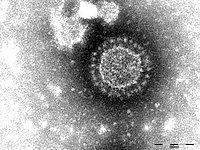
Photo from wikipedia
The outbreak of piglet diarrhoea caused by porcine epidemic diarrhoea virus (PEDV) began to spread in Southern China in late 2010 and resulted in significant economic losses throughout the country.… Click to show full abstract
The outbreak of piglet diarrhoea caused by porcine epidemic diarrhoea virus (PEDV) began to spread in Southern China in late 2010 and resulted in significant economic losses throughout the country. To determine the prevalence and the molecular characteristics of common PEDV strains in China, 1272 faeces and small intestine samples in pigs were collected from 17 provinces and inspected for PEDV; the full-length spike (S) gene of 18 detected PEDV strains collected from five eastern provinces were sequenced and analysed. The epidemiological data revealed that the PEDV-positive rate in diarrhoea specimens was 28.93%. Phylogenetic analysis of the S genes showed that the CH-JSYC-1-2016 strain was clustered into a G2-a subgroup (US and Asian non-S-INDEL), and other seventeen virus strains was clustered into a new subgroup G2-b (Chinese non-S-INDEL). The G2-b subgroup only contained Chinese PEDV strains that were isolated after 2014. Compared with the CV777 vaccine strain, Eastern China PEDVs were genetically distinct and had various amino acid differences in the neutralizing epitope domain of the S protein, as well as different patterns of predicted high-specificity N-glycosylation sites. The prevalence of Chinese non-S-INDEL strains may be responsible for the immunization failure by using currently available commercial vaccines (based on attenuated CV777 strain), and the development of novel vaccines based on these newly identified PEDV variants may contribute to the control of PED outbreaks in China.
Journal Title: Virus research
Year Published: 2018
Link to full text (if available)
Share on Social Media: Sign Up to like & get
recommendations!